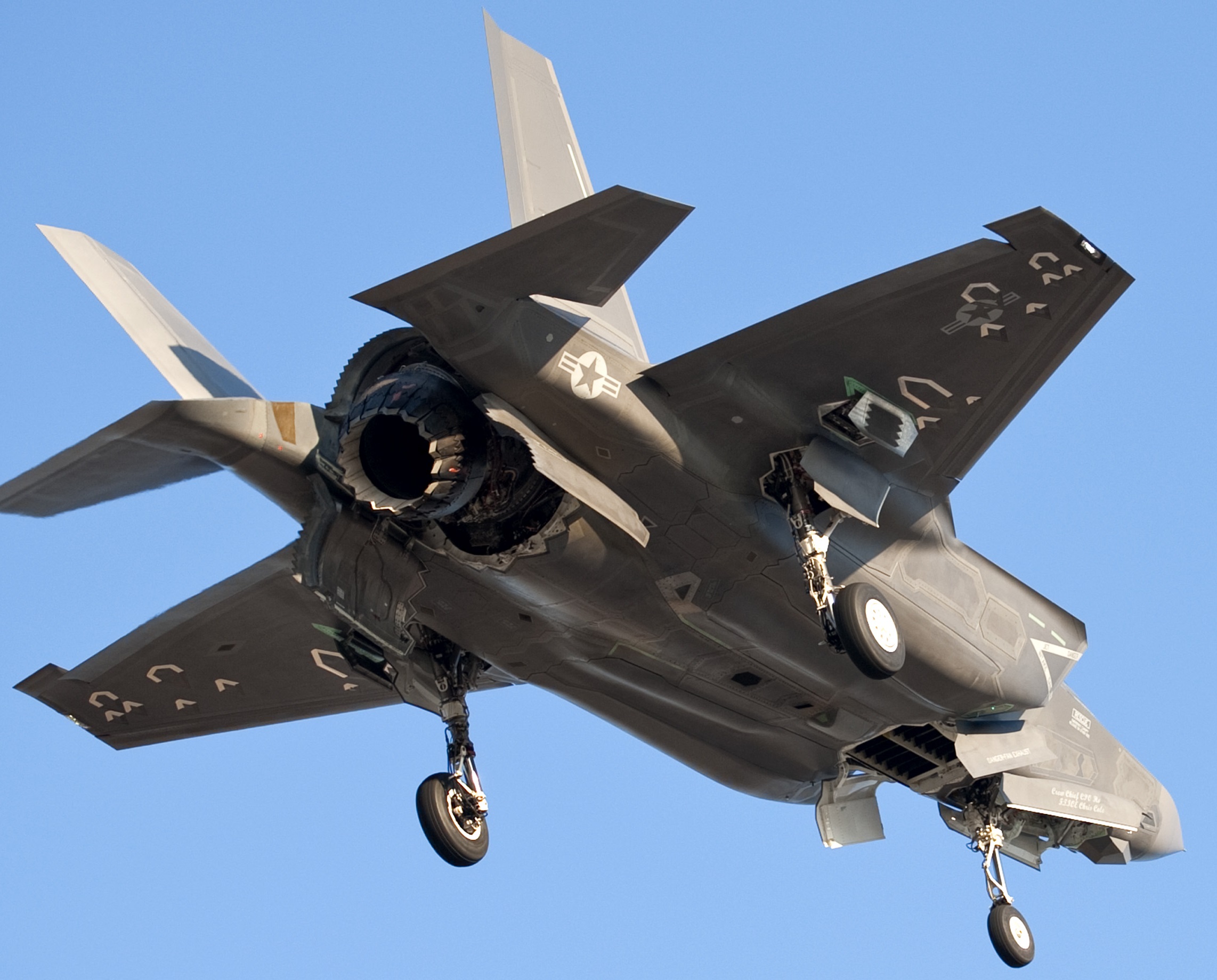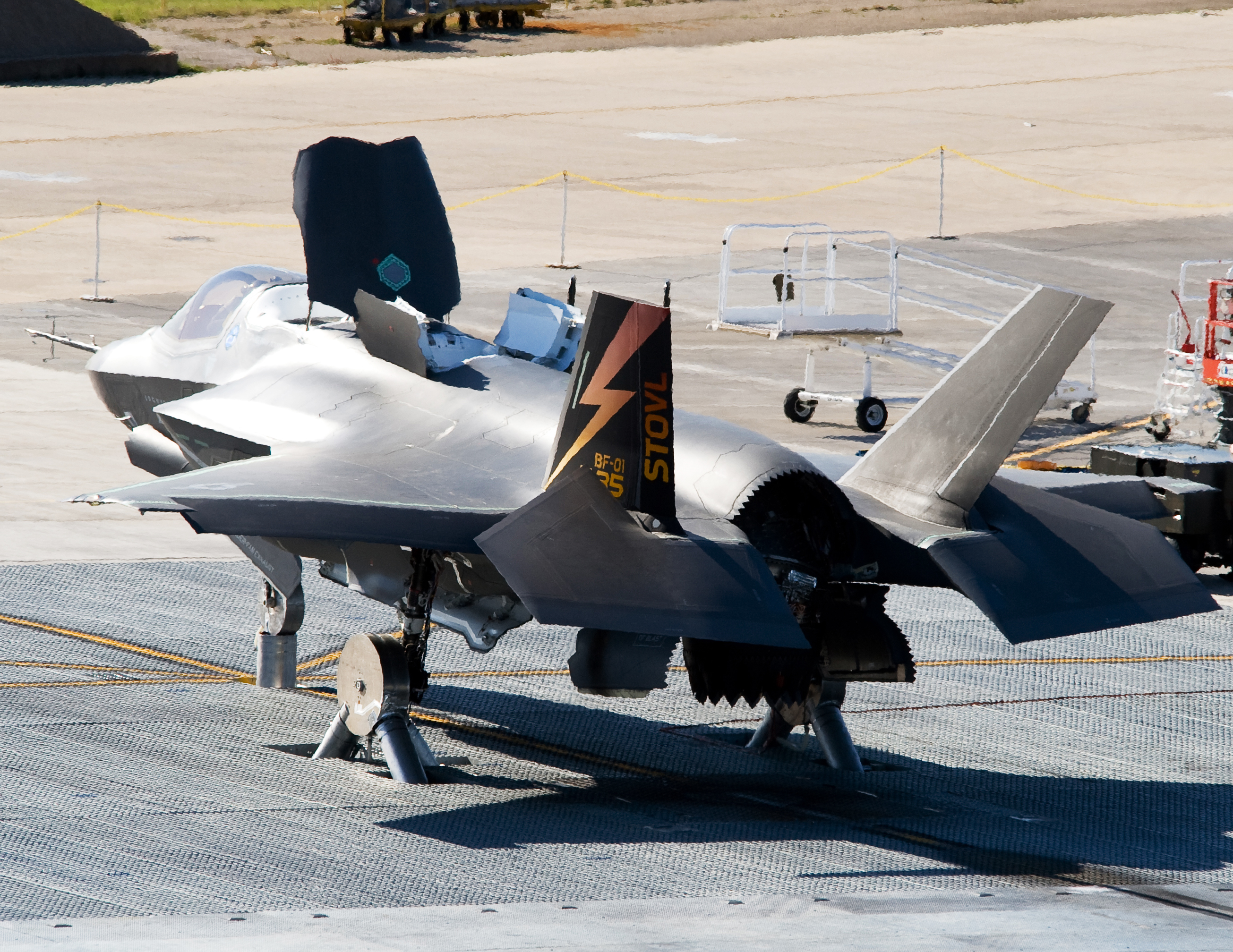Hover Fighter Jet - In a new video, Lockheed Martin's F-35B Supersonic Stealth Jet shows how much expensive jet fuel it burns without going anywhere at all.
In a new video, Lockheed Martin's F-35B Lightning II supersonic stealth jet shows how much expensive jet fuel it burns without going anywhere at all.
Hover Fighter Jet
The $83 million aircraft, officially the BF-1, recently put on this performance at Naval Air Station Patuxent River in Maryland.
Watch This F 35b Fighter Jet Nail A 100% Vertical Take Off And Landing
In this video, test pilot Graham Tomlinson watches as the F-35B remains stationary 150 feet above the runway:
So how does it work? Inside the jet is a vertical thrust fan driven by a shaft from the motor. The whole thing is covered by a "hood" (you can see it behind the cockpit, raised, in the video), and the small back doors allow the engine to float extra air, which requires considerable power to achieve. (Of course, the jet's exhaust also swings downward.)
The F-35B is planned to be used by the US Marine Corps and the British Royal Navy. The non-hovering version, the F-35A, is used by the US Air Force and several international customers.
A third version, the F-35C, is used by the US Navy to launch and intercept a catapult carrier.
F 35 Stealth Fighter In Hover Mode Editorial Photo
Related How to Turn Your Home's Old TV Cable into Powerful Ethernet Lines McDonald's has just launched a brilliant new way for customers to save money. Jet-powered attack aircraft capable of vertical/short take-off and landing (V/STOL) operations. Named after a bird of prey,
It was originally developed by British manufacturer Hawker Siddeley in the 1960s. The Harrier emerged as the only truly successful V/STOL design of the many attempts in that era. It was designed to operate from improvised bases, such as parking lots or forest clearings, without requiring large and vulnerable air bases. Later, the design was adapted for use by aircraft carriers.
There are two generations and four main variants of the Harrier family, developed by UK and US manufacturers:

The Hawker Siddeley Harrier is the first generation version and is also known as the AV-8A or AV-8C Harrier; it was used by many air forces, including the Royal Air Force (RAF) and the United States Marine Corps (USMC). The Sea Harrier is a naval attack/air defense fighter derived from the Hawker Siddeley Harrier; it was operated by both the Royal Navy and the Indian Navy. During the 1980s, the second generation Harrier appeared, produced in the US as the AV-8B and in the UK as the British Aerospace Harrier II. By the beginning of the 21st century, most of the first generation Harriers had been withdrawn, many operators had the choice to purchase the second generation as a replacement. In the longer term, several operators have announced their intention to replace or replace their Harrier fleets with the STOVL variant of the F-35 Lightning II, designated the F-35B.
F 35b Completes First Vertical Landing At Sea
During the 1950s, especially in the years after the Korean War, a number of aircraft companies in Europe and America separately decided to explore the potential capabilities and viability of vertical take-off and landing (VTOL) aircraft, which required the elimination of for vulnerable runways with vertical take-off and landing as opposed to a conventional horizontal approach.
In addition to military applications, the prospect of such technology on commercial aircraft was also viewed with considerable interest in the mid-1950s, so the value of developing sustainable vertical launch systems was deemed essential. However, during this era, some companies envisioned that the VTOL aircraft could also be compatible with the characteristics of high-performance military aircraft.
Bottom view of the first prototype P.1127. The jet's rotating nozzles were a key design element of its VTOL capability
During 1957, following the approach of the British aerofoil manufacturer Bristol Gin Company, who had designed an innovative thrust vectoring, the British aviation conglomerate Hawker Aircraft developed their design for an aircraft that met the existing NATO specification, which was a "Light Tactical support" he shouted. fighter".
F 35 Lightning In The Hover @ Riat 22 [3697x4420]
Attached rotating cold jets that were positioned on either side of the compressor along with a "hot" jet that was routed through a conventional ctral exhaust pipe; this concept came from Michel Wiebault, a French aviation consultant. During most of the early development work, there was no financial support for the project from the HM Ministry of Finance; however, support for part of the Gine development effort was through NATO's Mutual Weapons Development Program (MWDP) sources.
Project engineer Sior Ralph Hooper at Hawker immediately began building an initial layout for a theoretical aircraft to take advantage of the Pegasus Gine, using data supplied by Bristol.
In March 1959, the newly incorporated Hawker Siddeley decided to privately finance a pair of prototypes of the design, given the company's internal designation P.1127, to demonstrate the design's capabilities.

During the 1960s, the P.1127 attracted the attention of the RAF; this would eventually result in the development and release of the Requiremt ASR 384, which required a V/STOL aircraft for ground attack operations.
F 32b Fighter Jet Plane Hovering In The Sky Stock Photo
Around the same time as the RAF's interest in the concept, NATO developed its own specification, NBMR-3, which called for vertical take-off and landing (VTOL) aircraft; Specific requirements include the expectation that the performance of such an aircraft is equivalent to the McDonnell Douglas F-4 Phantom II conventional fighter. Specifications called for a supersonic V/STOL strike fighter with a combat radius of 460 kilometers (250 nmi), a cruise speed of Mach 0.92 and a speed of Mach 1.5.
During the early 1960s, Hawker began development of a supersonic version of the P.1127, designated the P.1150, culminating in the unsuccessful Hawker P.1154. The NBMR.3 also attracted other competitors, including the P.1154's main competitor, the Dassault Mirage IIIV. P.1154 was eventually chosen to meet NBMR-3; however, it did not result in orders.
On 6 December 1961, before the design was submitted to NATO, it was decided that the P.1154 would be developed with requirements for use by the Royal Air Force (RAF) and the Royal Navy (RN).
Type development therefore continued for some time; However, by October 1963 the Air Ministry was concerned about the progress of the project, noting that the effort to combine a strike aircraft and a fighter in one aircraft, and the attempt to fit the same airfield for both services, was "unwise".
Us F 22 Fighter Jets To Soon Hover Over The Pacific Amid Mounting Tensions With China
On 2 February 1965, work on the P.1154 was canceled by the new British government due to the cost of the prototype building site.
During 1964, the first of these began flights; The Kestrel was evaluated by the multinational "Tripartite Evaluation Squadron", which consisted of British, American and German pilots, to determine how well it could operate VTOL aircraft; evaluations were completed in November 1965.
During 1966, following the cancellation of the P.1154, the RAF decided to proceed with an order for a modified derivative of the P.1127/Kestrel for service, designated the Harrier GR.1.

The Hawker Siddeley Harrier GR.1/GR.3 and AV-8A Harrier were the first generation of the Harrier series, the first operational offensive approach and reconnaissance aircraft with vertical/short take-off and landing (V/STOL) capabilities. They were developed directly from the Hawker P.1127 prototype and Kestrel evaluation aircraft. On 18 April 1969, the Harrier GR.1 officially entered service with the RAF, where the Harrier conversion unit at RAF Wittering received its first aircraft.
Video: F 35 Fighter Jet Transitions From Hover To Forward Flight And Viewers React
The United States Marine Corps (USMC) also chose to purchase the type, acquiring 102 AV-8A and 8 TAV-8A Harriers between 1971 and 1976.
The British Aerospace Sea Harrier is a V/STOL naval jet fighter, reconnaissance and attack aircraft; it was a modified development of the Hawker Siddeley Harrier. The first version entered service with the Royal Navy's air arm in April 1980 as the Sea Harrier FRS.1 and was informally known as the Shar.
Sea Harriers played a major role in the 1982 Falklands War, flying from the aircraft carriers HMS Invincible and HMS Hermes.
War experiences led to the production of an improved model in the form of the upgraded Sea Harrier FA2; This version ended operational service on April 2, 1993.
China's New J 20 Stealth Fighter Screams On To Scene
The Sea Harrier was also purchased by the Indian Navy, where the first Indian Sea Harrier entered the squadron in December 1983.
As early as 1973, Hawker Siddeley and the American aircraft manufacturer McDonnell Douglas worked together to develop a more capable version of the Harrier. Early efforts focused on the development of an improved Pegasus Gine, designated the Pegasus 15, which was tested by Bristol Sideli.
In August 1981, the program received a boost, when British Aerospace (BAe) and McDonnell Douglas signed a Memorandum of Understanding (MoU), marking a new UK attempt at the programme.

The Harrier was extensively redesigned by McDonnell Douglas and later joined by British Aerospace (now parts of Boeing and BAE Systems, respectively), resulting in the second-generation V/STOL family of jet multirole aircraft. The American designation for it was the AV-8B Harrier II.
Vertical Take Off: Why China's J 31 Can't Compete With America's F 35b
On December 12, 1983, the first production AV-8B was delivered to the USMC. The AV-8B is primarily used for attack or multi-role missions, which usually operate
Second degree assault washington state, 2nd degree assault sentence, 2nd degree aggravated assault, 2nd degree assault mn, 2nd degree assault, 2nd degree assault definition, 3rd degree assault washington state, 4th degree assault washington state, 2nd degree felony assault, 4th degree assault washington, what is assault 2nd degree, 2nd degree assault charges